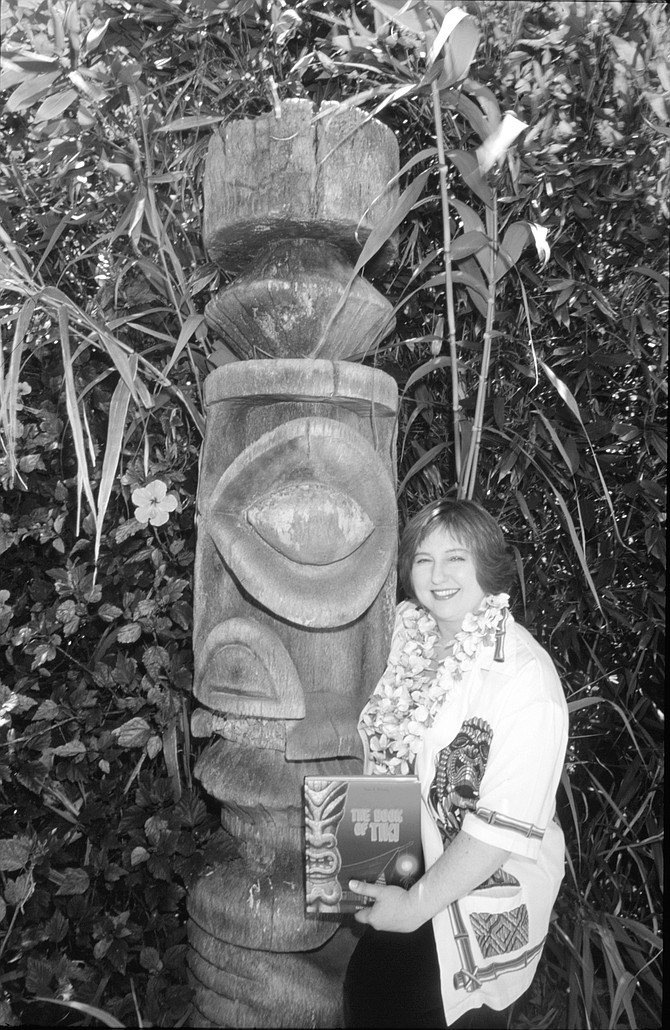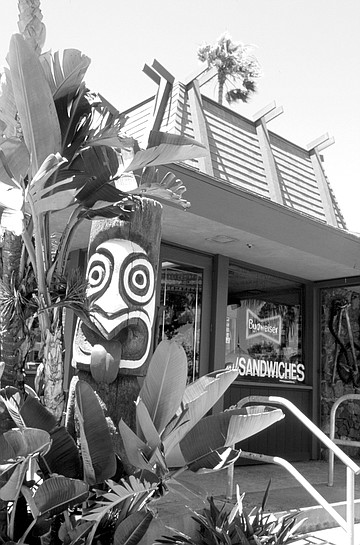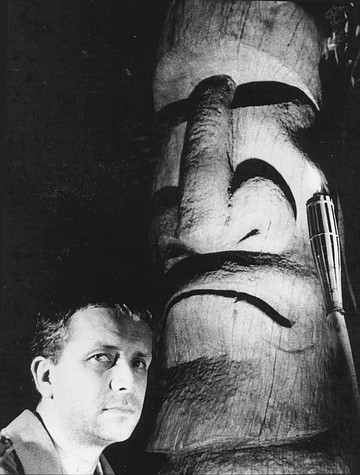 Facebook
Facebook
 X
X
 Instagram
Instagram
 TikTok
TikTok
 Youtube
Youtube

When you hear the word “tiki,” what comes to mind? Try sweaty drunks, sickly sweet mai tais, and mumus; loyalty oaths, bomb shelters, and mugs molded to resemble the tiki totem of Pacific Islanders. That is, the mugs portray the deity as it was inauthentically reimagined by American popular culture in the 1950s. All are reasons to rejoice when tiki-style buildings from that era are razed. Correct?

On the contrary, says local historian Alex Bevil. Buildings are historic precisely because they evoke a feeling, a sense of a time. “It doesn’t have to be a good feeling. Everything doesn’t have to be all comfy-cozy-Victorian-craftsman.” Ruminating about how to describe the social implications of A-framed, American tiki huts, Bevil says he came up with this: “Basically, they’re places where uptight squares would go native.”

Bevil is conducting a “windshield” survey, cruising San Diego in search of the genre’s best examples. It’s one step in establishing Polynesian pop (or whatever it’s eventually called) as a legitimate architectural mode that deserves respect, study, and preservation, just like Spanish or Dutch colonial revival.
“I took Shelter Island to be Ground Zero,” he says. “Now I’m moving out in concentric circles.” In addition to the still-intact Bali Ha’i and remnants of bygone tiki-inspired restaurants and hotels on the peninsula, Bevil considers Trader Mort’s Liquor & Deli, at the entrance to the causeway on Shelter Island Drive, to be “one of the most perfect tiki commercial buildings” he’s ever seen. Its name is taken from one of the craze’s originators, Victor Bergeron, a.k.a. Trader Vic.
Of tiki-styled private residences, Bevil says, “There’s this unbelievable house in Spring Valley — on Andreen Street. The owner says people call it the Flying Nun House, because the gables resemble her hat.”
Bevil has identified tiki religious properties, too, including an “outstanding” church on Echo Drive in La Mesa. It was Faith Chapel; now it’s the West Coast Worship Center. “When I first saw it, I said, ‘Hmm. That would make a perfect nightclub.’ There’s almost a generic pattern. It’s like, ‘What do you want? Nightclub or church?’ ”
In Clairemont, Bevil spotted a “quasi-religious, quasi-commercial” tiki funeral home. “It’s across from the library, which also has a slight tiki feel.” Both the library and the Mission Bay Information Center, at the end of Clairemont Drive, qualify as “municipal tiki,” says Bevil.
Finally, there is “tacked-on” tiki, exemplified by Mission Bay Automotive on Morena Boulevard. “I’m not sure when it went tiki, but at the time, somebody put on top of the central hut an actual figure — a typical, squat tiki, with big eyes, exaggerated, stubby limbs, and big, grinning mouth. It makes me wonder if Pacific Islanders are offended by these icons. Are they the equivalent of cigar-store Indians? People weren’t very sensitive back in the ’50s, but that’s another one of those connotations.”
On Sunday, Bevil will give a talk at the Bali Ha’i. “People like myself have to put tiki into context, so if someone says, ‘It’s tiki. It’s ’50s. So what?’ we have to answer them.”
Sven Kirsten, author of The Book of Tiki, will talk too. “In the tiki sections of certain cities, there was always one wildly successful tiki temple, and the Bali Ha’i was it for San Diego,” says the German-bom Kirsten by phone from his home in L.A. (In his front yard is a ten-foot tiki head.) “It was the Polynesian palace to go to, famous for its floor shows, which toured the U.S.”
For the ten years that he worked on his book, Kirsten, a director of photography for film and video, photographed the remnants of tiki culture around the country. His photographs include not only architecture but collectibles like matchbooks, menus, swizzle sticks, ashtrays, and, of course, those mugs. The matchbooks were key. Working from their addresses, he found many of the old places, or not, if they had already been demolished.
“Some people call it Kon-Tiki style,” says Kirsten, referring to Thor Heyerdahl’s 1950s best-seller. James Michener’s Tales of the South Pacific was another book that both fueled and reflected tiki mania. “The style was ignored by culture critics in its own time, because it was a purely popular phenomenon.”
Having grown up elsewhere, Kirsten admits he harbors no bad tiki-connotations and can experience it as a pure form. Conversely, he says, “In Europe, there’s a strong sense of what good taste is. Here you have more freedom both to create according to your vision and to appreciate more widely.” Louise Torio of Historic San Diego will lead a walking tour on Shelter Island prior to the talks. “We’re at the 50-year mark, where things are saved or lost,” she says. Those who remodel away tiki “are unaware that people go to eat someplace not because it looks like every other darn restaurant, but because they can say of it, ‘Oh, wow. That’s California.’ Or ‘That’s San Diego.’” Describing herself as a frequent testifier at city council meetings, she adds: “You have to convince business owners, because five years from now, they’re gonna go, ‘Oh, my God! What did I do?’ ”


When you hear the word “tiki,” what comes to mind? Try sweaty drunks, sickly sweet mai tais, and mumus; loyalty oaths, bomb shelters, and mugs molded to resemble the tiki totem of Pacific Islanders. That is, the mugs portray the deity as it was inauthentically reimagined by American popular culture in the 1950s. All are reasons to rejoice when tiki-style buildings from that era are razed. Correct?

On the contrary, says local historian Alex Bevil. Buildings are historic precisely because they evoke a feeling, a sense of a time. “It doesn’t have to be a good feeling. Everything doesn’t have to be all comfy-cozy-Victorian-craftsman.” Ruminating about how to describe the social implications of A-framed, American tiki huts, Bevil says he came up with this: “Basically, they’re places where uptight squares would go native.”

Bevil is conducting a “windshield” survey, cruising San Diego in search of the genre’s best examples. It’s one step in establishing Polynesian pop (or whatever it’s eventually called) as a legitimate architectural mode that deserves respect, study, and preservation, just like Spanish or Dutch colonial revival.
“I took Shelter Island to be Ground Zero,” he says. “Now I’m moving out in concentric circles.” In addition to the still-intact Bali Ha’i and remnants of bygone tiki-inspired restaurants and hotels on the peninsula, Bevil considers Trader Mort’s Liquor & Deli, at the entrance to the causeway on Shelter Island Drive, to be “one of the most perfect tiki commercial buildings” he’s ever seen. Its name is taken from one of the craze’s originators, Victor Bergeron, a.k.a. Trader Vic.
Of tiki-styled private residences, Bevil says, “There’s this unbelievable house in Spring Valley — on Andreen Street. The owner says people call it the Flying Nun House, because the gables resemble her hat.”
Bevil has identified tiki religious properties, too, including an “outstanding” church on Echo Drive in La Mesa. It was Faith Chapel; now it’s the West Coast Worship Center. “When I first saw it, I said, ‘Hmm. That would make a perfect nightclub.’ There’s almost a generic pattern. It’s like, ‘What do you want? Nightclub or church?’ ”
In Clairemont, Bevil spotted a “quasi-religious, quasi-commercial” tiki funeral home. “It’s across from the library, which also has a slight tiki feel.” Both the library and the Mission Bay Information Center, at the end of Clairemont Drive, qualify as “municipal tiki,” says Bevil.
Finally, there is “tacked-on” tiki, exemplified by Mission Bay Automotive on Morena Boulevard. “I’m not sure when it went tiki, but at the time, somebody put on top of the central hut an actual figure — a typical, squat tiki, with big eyes, exaggerated, stubby limbs, and big, grinning mouth. It makes me wonder if Pacific Islanders are offended by these icons. Are they the equivalent of cigar-store Indians? People weren’t very sensitive back in the ’50s, but that’s another one of those connotations.”
On Sunday, Bevil will give a talk at the Bali Ha’i. “People like myself have to put tiki into context, so if someone says, ‘It’s tiki. It’s ’50s. So what?’ we have to answer them.”
Sven Kirsten, author of The Book of Tiki, will talk too. “In the tiki sections of certain cities, there was always one wildly successful tiki temple, and the Bali Ha’i was it for San Diego,” says the German-bom Kirsten by phone from his home in L.A. (In his front yard is a ten-foot tiki head.) “It was the Polynesian palace to go to, famous for its floor shows, which toured the U.S.”
For the ten years that he worked on his book, Kirsten, a director of photography for film and video, photographed the remnants of tiki culture around the country. His photographs include not only architecture but collectibles like matchbooks, menus, swizzle sticks, ashtrays, and, of course, those mugs. The matchbooks were key. Working from their addresses, he found many of the old places, or not, if they had already been demolished.
“Some people call it Kon-Tiki style,” says Kirsten, referring to Thor Heyerdahl’s 1950s best-seller. James Michener’s Tales of the South Pacific was another book that both fueled and reflected tiki mania. “The style was ignored by culture critics in its own time, because it was a purely popular phenomenon.”
Having grown up elsewhere, Kirsten admits he harbors no bad tiki-connotations and can experience it as a pure form. Conversely, he says, “In Europe, there’s a strong sense of what good taste is. Here you have more freedom both to create according to your vision and to appreciate more widely.” Louise Torio of Historic San Diego will lead a walking tour on Shelter Island prior to the talks. “We’re at the 50-year mark, where things are saved or lost,” she says. Those who remodel away tiki “are unaware that people go to eat someplace not because it looks like every other darn restaurant, but because they can say of it, ‘Oh, wow. That’s California.’ Or ‘That’s San Diego.’” Describing herself as a frequent testifier at city council meetings, she adds: “You have to convince business owners, because five years from now, they’re gonna go, ‘Oh, my God! What did I do?’ ”
Comments